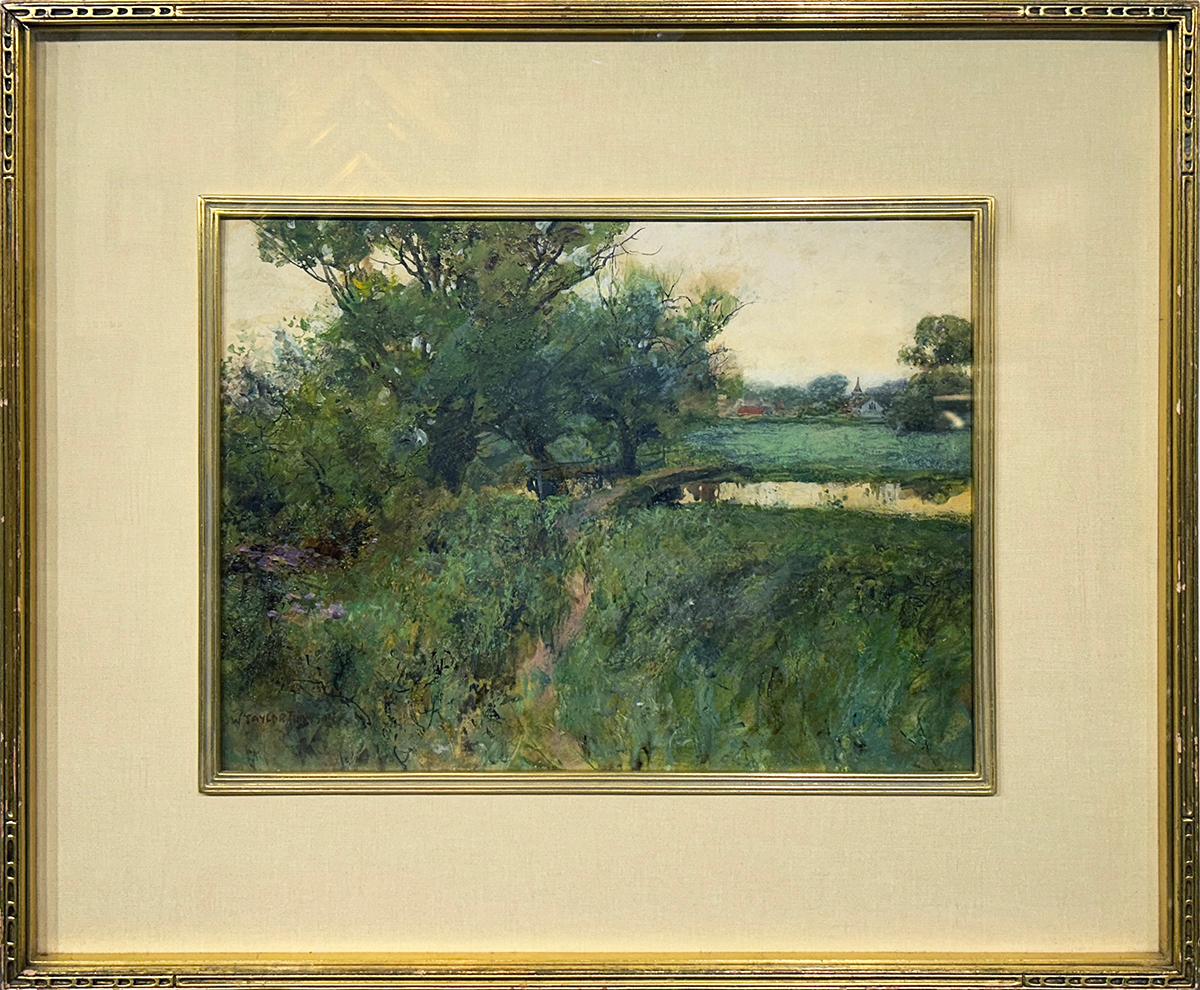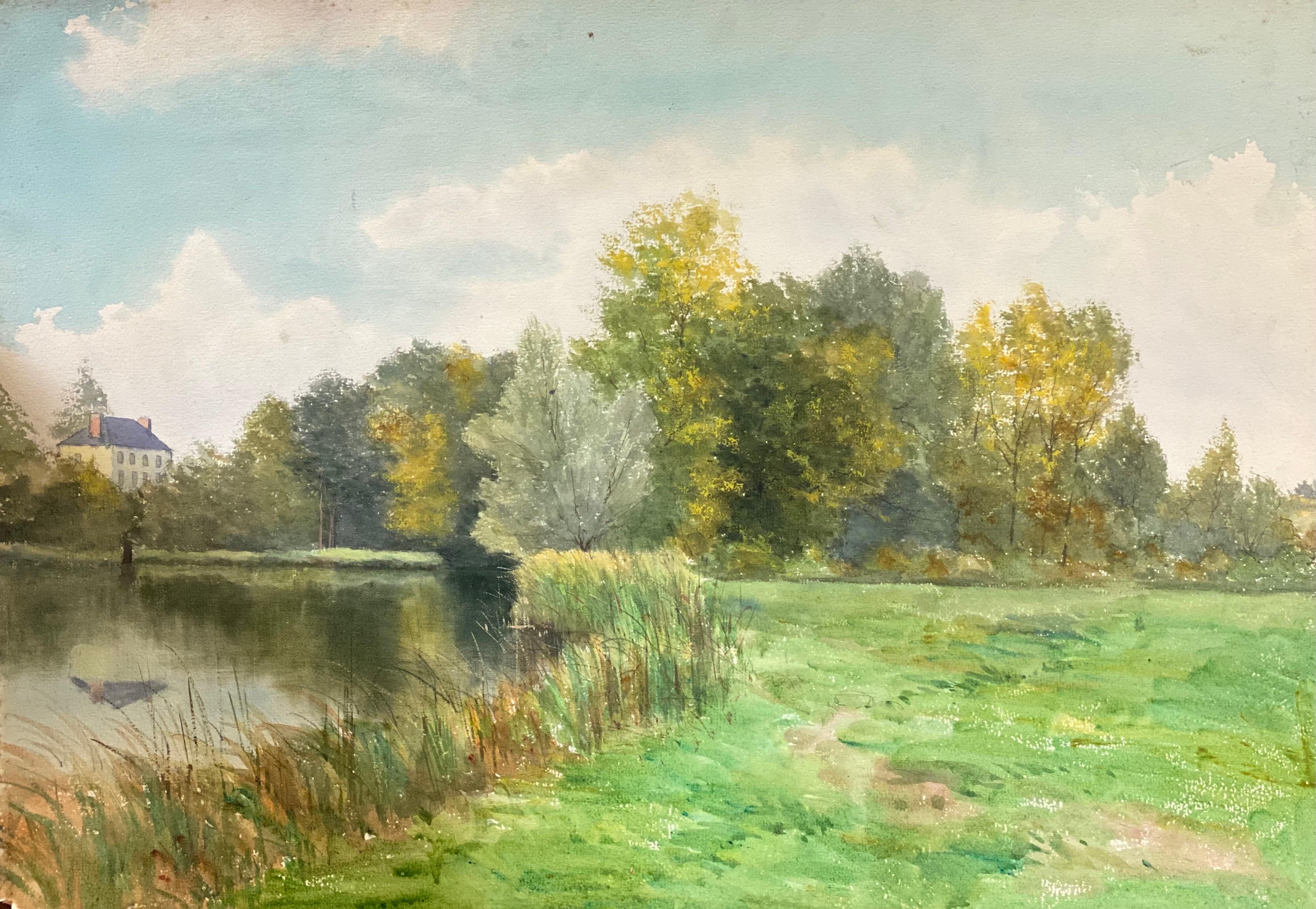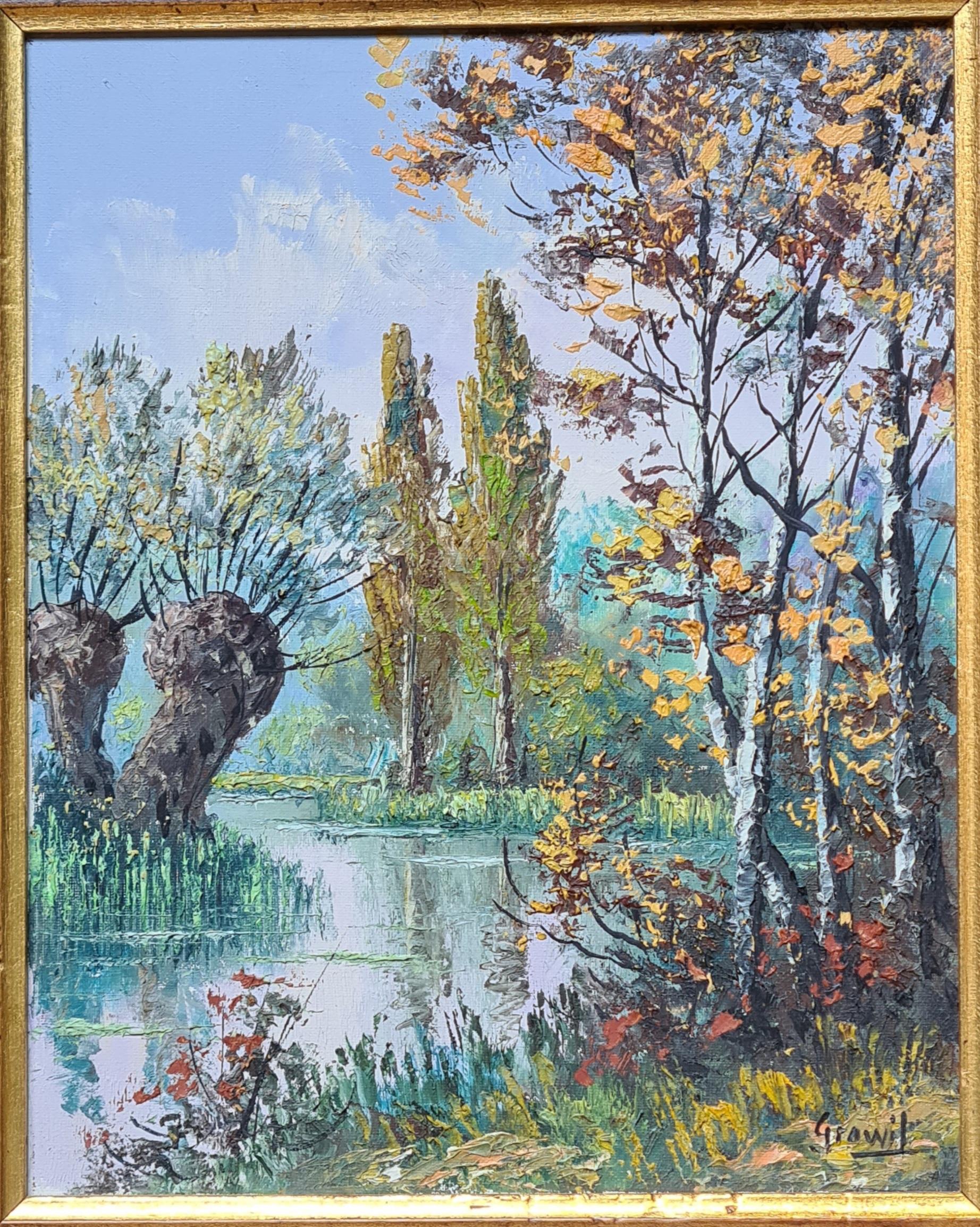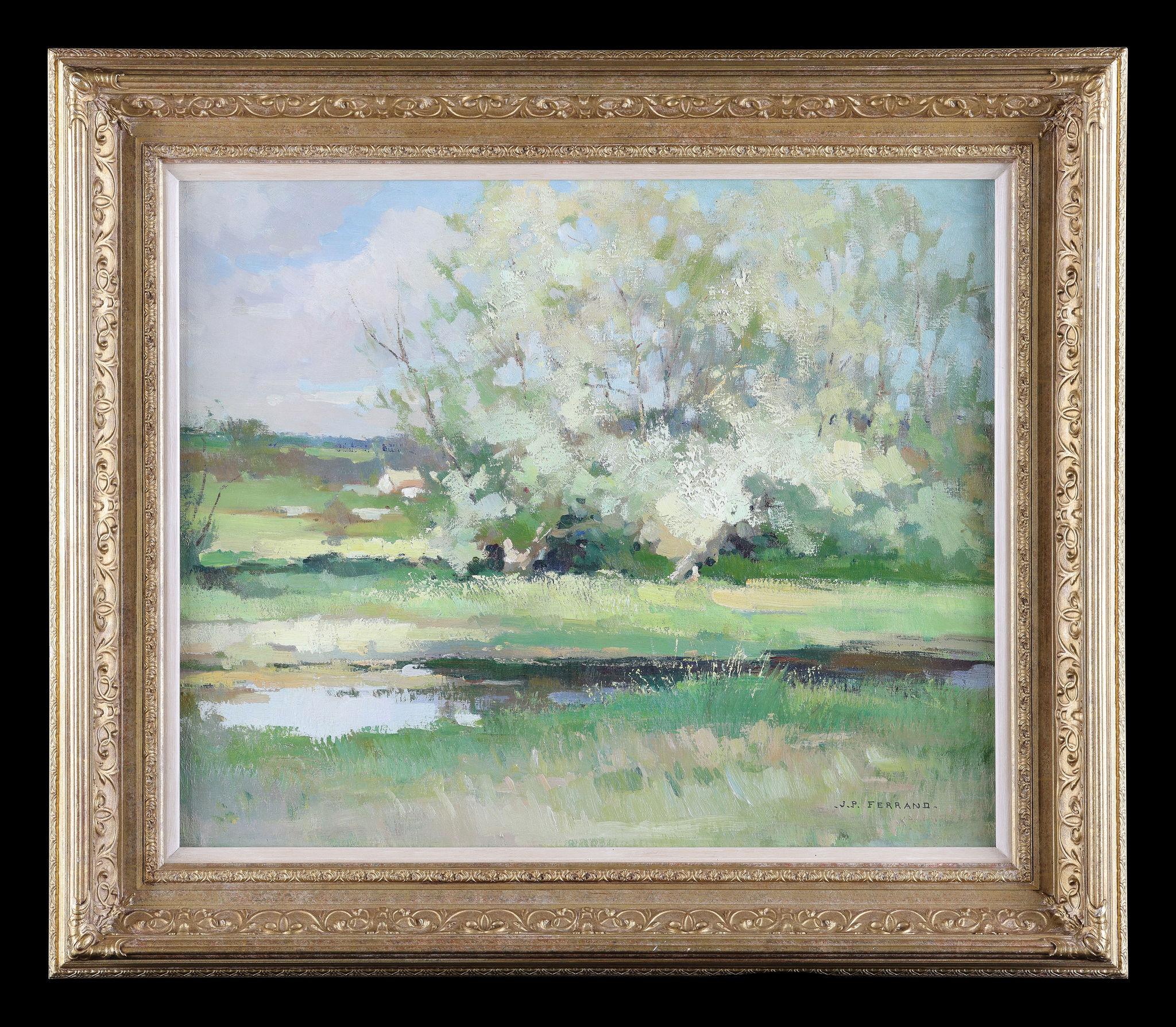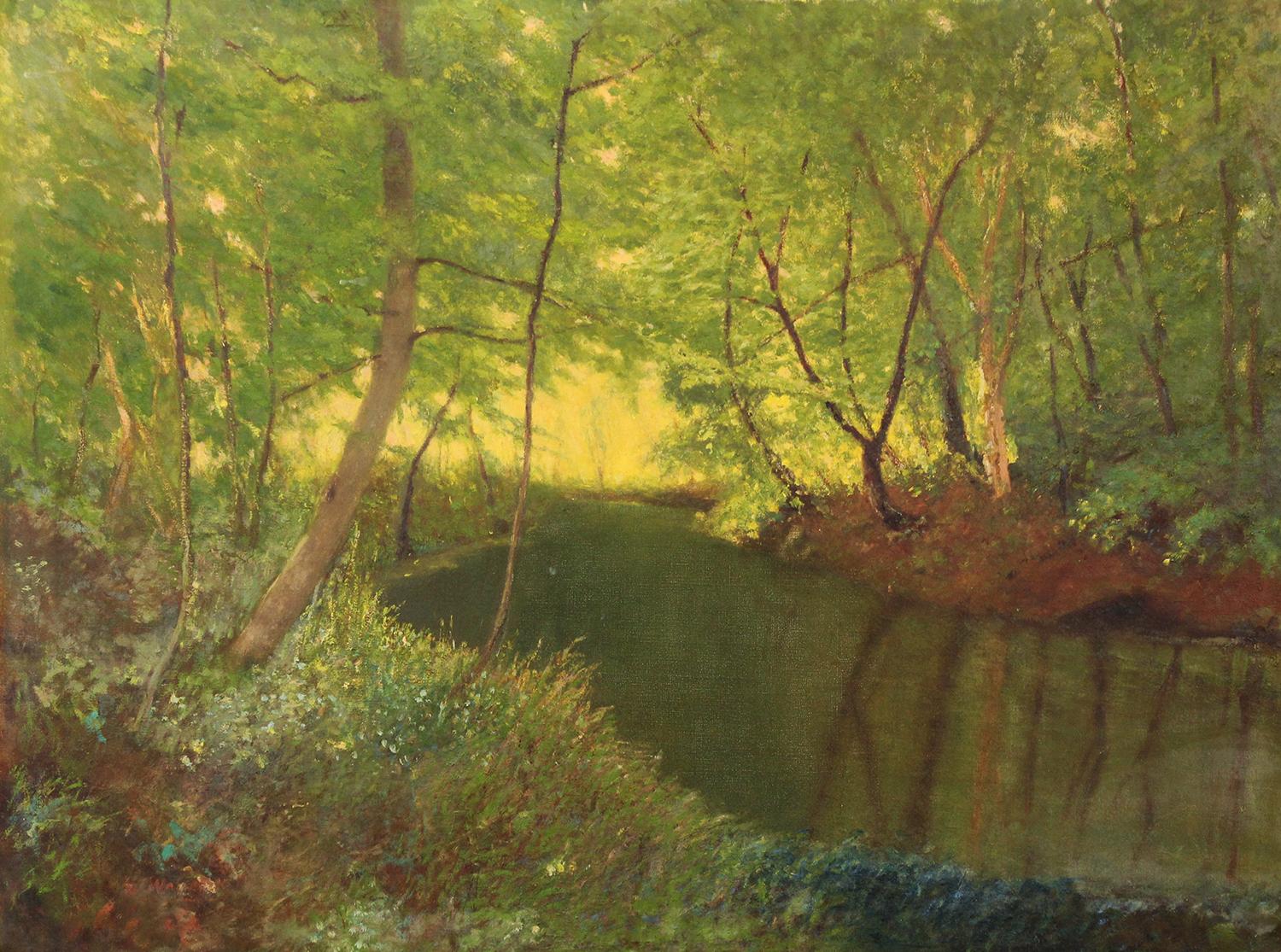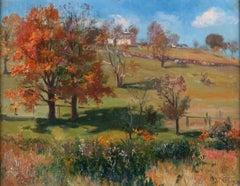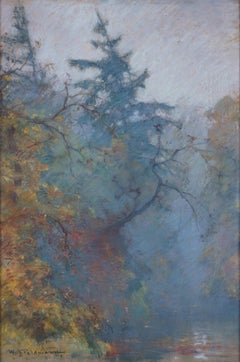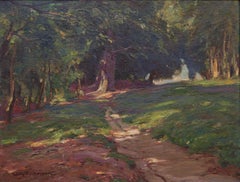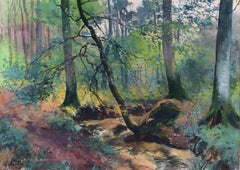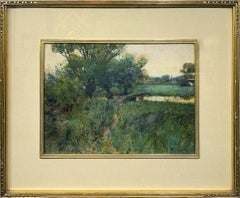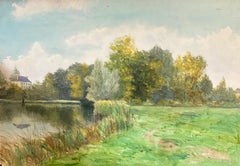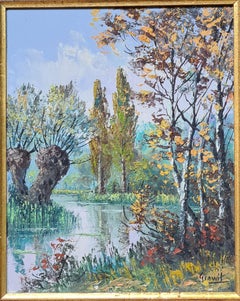Items Similar to Late Summer River Landscape / - Realistic Impression -
Video Loading
Want more images or videos?
Request additional images or videos from the seller
1 of 11
Jan Hillebrand WijsmüllerLate Summer River Landscape / - Realistic Impression -c. 1900
c. 1900
$3,616.34
$4,520.4320% Off
£2,679.07
£3,348.8420% Off
€3,040
€3,80020% Off
CA$4,974.07
CA$6,217.5920% Off
A$5,532.59
A$6,915.7420% Off
CHF 2,902.39
CHF 3,627.9920% Off
MX$67,510.18
MX$84,387.7320% Off
NOK 36,428.65
NOK 45,535.8220% Off
SEK 34,329.59
SEK 42,911.9920% Off
DKK 23,146.16
DKK 28,932.7020% Off
About the Item
Jan Hillebrand Wijsmuller (1855 Amsterdam - 1925 ibid.), Late Summer River Landscape, oil on canvas, relined, 34 x 56 cm (inside measurement), 43 x 64 cm (frame), signed J[an] H[illebrand] Wijsmuller at lower right.
- in good condition, the frame with isolated bumped spots
- Realistic Impression -
About the artwork
The panoramic landscape format shows a river landscape, with the course of the river, which curves to the right, leading the eye into the depths of the picture and tempting it to continue the landscape in the imagination beyond the visible area. At the same time, however, the fact that the landscape is not visible through the bend in the river focuses our gaze on the entirety of the landscape depicted, without prompting us to focus on distant details. Accordingly, the brushstroke is not designed to render details with realistic precision. In the front left area of the river there is even a completely free brushwork, trained by Impressionism, which nevertheless remains committed to representational and convincingly suggests the movement of the water.
Regardless of the distance of the observer, the entire picture is painted with the same broad brushstroke, so that the landscape is given as an impression. And yet this impression is not ephemeral, as in the case of French Impressionism, to put it exaggeratedly, but reveals to us the essence of the landscape in all its richness. This is why the Dutch variant of Impressionism is always also a realism, although the pictures appear less progressive, but still contain a dimension of landscape painting that is lost with progress.
In the impression, the reality of the landscape is revealed, and this happens as we experience the landscape in the visual impression. Wijsmuller does not depict houses or people in order to allow the experience of the landscape to fully unfold. The experience is determined first and foremost by the river, which does not flow into the picture from our point of view, but towards us. Where the river begins to bend, the water is churned by a rapids. Toward us, the riverbed widens and the water comes to rest, covering the entire width of the foreground like a mirror.
The stillness of the water corresponds to the evening mood of the late summer landscape, in which the warm tones of the evening light blend with the yellow and brown tones of the plants. A gentle, almost idyllic reality, carried by the brushstroke, yet animated by a liveliness that is also made visible by the brushstroke. The broad, dynamically placed brushstrokes evoke the movement of the treetops and animate even the immobile reeds, while the trunks on the right bank, executed in virtuoso white strokes that seem like markings, make the sunlight shine. On the other bank, a carpet of light also spreads out, its energetic effect again expressed in the brushstroke. The dynamic of the landscape is further enhanced by the complementary color contrasts between the greens, yellows, and browns on the one hand and the blue of the all-encompassing sky on the other. A contrast that is intensified by the reflection in the water.
The evening coming to rest of the landscape is thus at the same time an all-encompassing contrasting and yet in itself harmonious movement. This reality becomes accessible to us as an experience in the impression of the landscape.
About the artist
Jan Hillebrand Wijsmuller entered the Royal Academy of Arts in Amsterdam in 1876 and studied under the innovative Professor August Allebé, who was famous for the Amsterdam Impressionism, also known as the Allebé School.
In 1877, Wijsmuller transferred to the Hague Academy of Art, and thus to the Hague School, and then completed his studies at the Brussels Academy of Art. Returning to the Netherlands, Wijsmuller opened his own studio in Amsterdam.
In 1883 he won the prestigious Young Artist Award, donated by Willink van Collen, which made Wijsmuller a well-known and sought-after artist.
Wijsmuller was a member of the Societät Arti et Amicitiae Amsterdam and the Pulchri Studio in The Hague.
Wijsmuller belongs to the second generation of the Hague School. While Vincent van Gogh described the protagonists of the first generation to his brother Theo as "the great gray people," the second generation, and Wijsmuller in particular, used a much more colorful palette. His oeuvre makes him a major player in Dutch Impressionism, the second Golden Age of Dutch painting.
Selection of public collections that own paintings by Jan Hillebrand Wijsmuller:
Historisches Museum, Amsterdam / Rijksmuseum, Amsterdam / Stedelijk Museum, Amsterdam / Museum Willet-Holthuysen, Amsterdam / Dordrechts Museum, Dordrecht / Dienst Verspreide Rijkscollecties, Den Haag / Gemeentemuseum, Den Haag / Museum Mesdag, Den Haag / Stadhuis, Den Haag / Goois Museum, Hilversum / Zeeuws Museum, Middelburg / St. Vrienden Museum Noordwijk, Noordwijk / Belasting & Douane Museum, Rotterdam
GERMAN VERSION
Jan Hillebrand Wijsmuller (1855 Amsterdam - 1925 ebd.), Spätsommerliche Flusslandschaft, Öl auf Leinwand, doubliert, 34 x 56 cm (Innenmaß), 43 x 64 cm (Rahmen), rechts unten mit „J[an] H[illebrand] Wijsmuller“ signiert.
- in gutem Zustand, der Rahmen mit vereinzelten bestoßenen Stellen
Exposé als PDF
- Realistische Impression -
zum Kunstwerk
Das panoramaartige Querformat zeigt eine Flusslandschaft, wobei der nach rechts geschwungene Flusslauf den Blick in die Tiefe des Bildes hineinführt und dazu verleitet, die Landschaft in der Vorstellung über den sichtbaren Bereich hinaus fortzusetzen. Dass sich die Landschaft durch die Biegung des Flusses entzieht, konzentriert unseren Blick aber zugleich auf den präsentierten Landschaftsausschnitt im Ganzen, ohne dazu angespornt zu werden, entfernte Details fokussieren zu wollen. Dementsprechend ist auch der Pinselduktus nicht darauf angelegt, Details in einer realistischen Präzision zu gewahren. Im linken vorderen Bereich des Flusses ist gar eine ganz freie, vom Impressionismus geschulte Pinselführung zu gewahren, die dennoch dem Gegenständlichen verpflichtet bleibt und überzeugend die Bewegung des Wassers suggeriert.
Unabhängig von der dargestellten Entfernung des Betrachters ist das ganze Bild in demselben breiten Pinselduktus gehalten, wodurch die Landschaft als ein Eindruck, also als Impression gegeben ist. Und doch ist die Impression nichts Ephemeres, wie dies – überspitzt formuliert – im französischen Impressionismus der Fall ist, sie erschließt uns in ihrer Reichhaltigkeit das Wesen der Landschaft. Daher ist die niederländische Variante des Impressionismus immer zugleich auch ein Realismus, wodurch die Bilder freilich weniger progressiv erscheinen, dafür aber weiterhin eine Dimension der Landschaftsmalerei enthalten, die mit der Progression verloren geht.
In der Impression wird die Realität der Landschaft offenbar und dies geschieht, indem wir im Seheindruck die Landschaft erleben. Um das Landschaftserlebnis zur vollen Wirkung kommen zu lassen, stellt Wijsmuller keinerlei Häuser oder Menschen dar. Zunächst wird das Erlebnis vom Fluss bestimmt, der nicht – unserer Blickrichtung entsprechend – ins Bild hinein, sondern auf uns zu fließt. Dort, wo die Krümmung des Flusses einsetzt, ist das Wasser durch eine Stromschnelle aufgewühlt. Zu uns hin weitet sich das Flussbett und das Wasser kommt zur Ruhe, so dass es wie ein Spiegel die ganze Breite des Bildvordergrundes durchmisst.
Das Zur-Ruhe-Kommen des Wassers entspricht der Abendstimmung der spätsommerlichen Landschaft, in der sich das warmtonale Abendlicht mit den Gelb- und Brauntönen der Pflanzen vermählt. Eine vom Pinselduktus mitgetragene sanfte, beinahe idyllische Realität, die dennoch von einer ebenfalls durch den Pinselduktus sichtbar gemachten Lebendigkeit beseelt ist. Die breiten dynamisch gesetzten Pinselstriche evozieren eine Bewegtheit der Baumkronen und vitalisieren auch das unbewegte Schilf, während die in weißen virtuosen Strichlagen ausgeführten, wie Markierungen wirkenden Stämme am rechten Ufer das Sonnenlicht zum Aufleuchten bringen. Auf der anderen Uferseite breitet sich ebenfalls ein Lichtteppich aus, dessen energetische Wirkung abermals im Pinselduktus zum Ausdruck kommt. Zur Dynamik der Landschaft gehören auch die sich ergänzenden Farbkontraste, die Grün-, Gelb- und Brauntöne einerseits und das Blau des alles überspannenden Himmels andererseits. Ein Kontrast, der durch die Spiegelung im Wasser zusätzlich intensiviert wird.
Das abendliche Zur-Ruhe-Kommen der Landschaft ist also zugleich eine allumfassende kontrastreiche und dennoch in sich harmonische Bewegtheit. Diese Realität wird uns in der Impression der Landschaft als Erlebnis zugänglich.
zum Künstler
Jan Hillebrand Wijsmuller trat 1876 in die Königliche Kunstakademie Amsterdam ein und studierte bei dem innovativen Professor August Allebé, der namentlich für den Amsterdamer Impressionismus einsteht, der auch Schule von Allebé genannt wird.
1877 wechselte Wijsmuller zur Kunstakademie in Den Haag und damit zur Haager Schule, um anschließend sein Studium an der Kunstakademie in Brüssel zu vollenden. In die Niederlande zurückgekehrt, eröffnete Wijsmuller in Amsterdam ein eigenes Atelier.
1883 gewann er den von Willink van Collen gestifteten prestigeträchtigen Förderpreis für junge Künstler, der Wijsmuller zu einem bekannten und gefragten Künstler hat werden lassen.
Er war Mitglied der Societät Arti et Amicitiae Amsterdam sowie der Künstlervereinigung Pulchri Studio in Den Haag.
Wijsmuller zählt zur zweiten Generation der Haager Schule. Hatte Vincent van Gogh die Protagonisten der ersten Generation seinem Bruder Theo gegenüber als „die großen grauen Leute“ bezeichnet, bedient sich die zweite Generation, und dabei insbesondere Wijsmuller, einer deutlich farbintensiveren Palette. Mit seinem Oeuvre ist er ein wichtiger Akteur des niederländischen Impressionismus, dem zweiten Goldenen Zeitalter der Niederländischen Malerei.
Auswahl öffentlicher Sammlungen, die Bilder von Jan Hillebrand Wijsmuller besitzen:
Historisches Museum, Amsterdam / Rijksmuseum, Amsterdam / Stedelijk Museum, Amsterdam / Museum Willet-Holthuysen, Amsterdam / Dordrechts Museum, Dordrecht / Dienst Verspreide Rijkscollecties, Den Haag / Gemeentemuseum, Den Haag / Museum Mesdag, Den Haag / Stadhuis, Den Haag / Goois Museum, Hilversum / Zeeuws Museum, Middelburg / St. Vrienden Museum Noordwijk, Noordwijk / Belasting & Douane Museum, Rotterdam
- Creator:Jan Hillebrand Wijsmüller (1855 - 1925, Dutch)
- Creation Year:c. 1900
- Dimensions:Height: 16.54 in (42 cm)Width: 25.2 in (64 cm)Depth: 1.97 in (5 cm)
- Medium:
- Movement & Style:
- Period:
- Condition:
- Gallery Location:Berlin, DE
- Reference Number:1stDibs: LU2438212727962
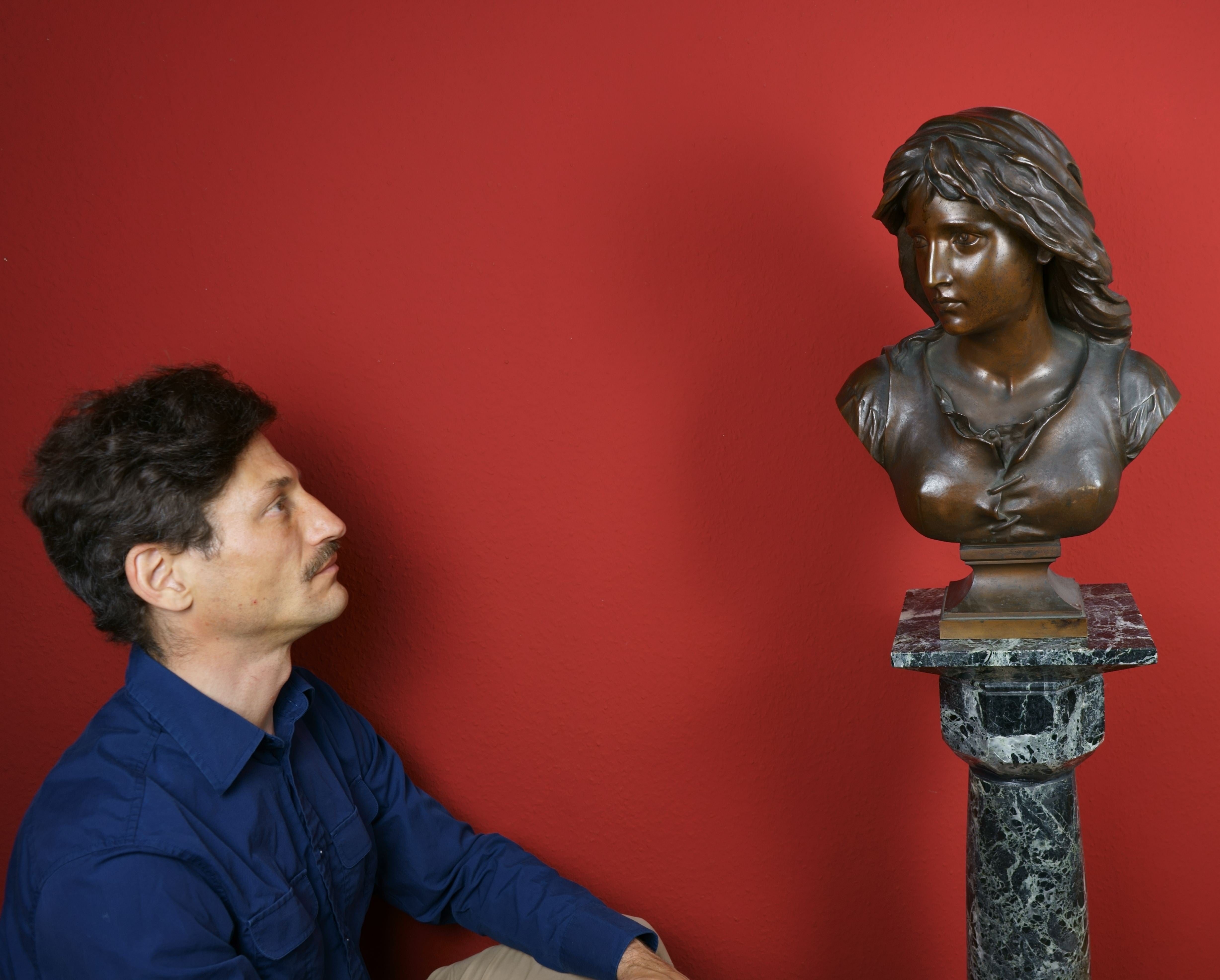
About the Seller
5.0
Vetted Professional Seller
Every seller passes strict standards for authenticity and reliability
Established in 2014
1stDibs seller since 2023
21 sales on 1stDibs
- ShippingRetrieving quote...Shipping from: Berlin, Germany
- Return Policy
Authenticity Guarantee
In the unlikely event there’s an issue with an item’s authenticity, contact us within 1 year for a full refund. DetailsMoney-Back Guarantee
If your item is not as described, is damaged in transit, or does not arrive, contact us within 7 days for a full refund. Details24-Hour Cancellation
You have a 24-hour grace period in which to reconsider your purchase, with no questions asked.Vetted Professional Sellers
Our world-class sellers must adhere to strict standards for service and quality, maintaining the integrity of our listings.Price-Match Guarantee
If you find that a seller listed the same item for a lower price elsewhere, we’ll match it.Trusted Global Delivery
Our best-in-class carrier network provides specialized shipping options worldwide, including custom delivery.More From This Seller
View AllAutumn Landscape in Sunlight - Indian Summer -
Located in Berlin, DE
Frederick Vezin (1859 Torresdale Philadelphia - 1933 Düsseldorf), Autumn Landscape in the Sunlight, oil on canvas, mounted on cardboard, 32 x 41 cm (inside measurement), 44 x 51 cm (frame), signed and dates lower right "F. Vezin. [19]05".
- Cardboard slightly curved, small inconspicuous retouch at the centre of the upper edge of the picture.
About the artwork
Although the painting appears to be a sketch, Frederick Vezin considered it to be a finished work of art, as evidenced by his signature on the lower right. And it is precisely this sketchy quality that leads to an understanding of the painting, which was certainly created in the landscape itself: the natural phenomena were to be depicted artistically at the moment of their observation. This is not done by meticulously sketching nature, but - and here Vezin follows the teaching of French Impressionism - by illustrating nature in its visual fullness. The artist's eye is, as it were, immersed in the visuality of nature, which is made visible by his hand. The painting is therefore not a reflection of the landscape, but its artistic intensification.
This intensification also includes the fact that the foreground of the painting - corresponding to the field of vision - eludes a detail-oriented close-up view. Instead, the spatula-like application of paint, the vertical structure of which corresponds to the structure of the floral growth, has the effect of making nature tangible in its colourful substance.
At the same time, the foreground, which remains indeterminate in its concrete objectivity, creates an atmospheric space that connects with the actual protagonist of the picture, the group of trees, which flares up in shades of red and brown. Here, too, the leaves are more speckled than clearly outlined. It is precisely this 'sketchiness' that opens up a visual experience that makes the landscape accessible in its visual fullness, thus revealing its essence.
In addition to this abundance, the landscape is presented as a structure of order in that the composition of the picture makes the composition of the landscape visible. For example, the group of trees forms a distinct dark green shadow, which is repeated in the shadows cast by the trees behind it. A patterned diagonal axis is created in the picture, which is composed in this way by the landscape itself.
Strictly speaking, this is a cultivated landscape: a fence at the bottom and a low stone wall at the top, running from left to right, are two elements that also have a strong compositional effect. And on the top of the hill, a stone house is embedded in the landscape as the brightest surface in the picture. Nature and culture here form a harmonious synthesis, giving the painting an Arcadian touch.
In order to give the landscape as much space as possible, the horizon line is raised, but the design of the sky is also crucial. The clouds, combined with the shapes of the trees, create a bright blue sky. To the European eye, such a sky is reminiscent of a summer landscape. Accordingly, within the seasonal cycle, the blue sky is reserved for summer, and French Impressionism is also primarily an ode to summer. In Vezin's painting, however, the brilliant blue sky stands above an autumnal landscape, some of the trees even defoliated. It can therefore be assumed that the painting was made not in Europe but in the United States, and that it illustrates the proverbial Indian summer, making Frederick Vezin a pioneer of American landscape painting.
About the artist
Frederick Vezin was the son of a French immigrant to the United States and a German-born mother. This predestined him to promote artistic exchange between the old and new worlds. Having spent part of his schooling in Germany, in 1876, at the age of 20, he enrolled at the Düsseldorf Academy of Art, where he studied with Peter Janssen the Elder, Eduard von Gebhardt and Wilhelm Sohn, among others. He graduated in 1883, settled in Munich and returned to Düsseldorf in 1895, where he lived until his death in 1933.
A native of the United States, he travelled to the country frequently and became a popular portrait and society painter. His artistic talent, however, was most evident in his landscape paintings. Trained in French Impressionism, he developed a virtuoso use of colour and a free brushwork that remained tied to the landscape motif, opening up the landscape itself in a new way. Frederick Vezin turned his attention primarily to the landscape of his homeland, becoming a pioneer of modern American landscape...
Category
Early 1900s Impressionist Landscape Paintings
Materials
Cardboard, Oil
$2,090 Sale Price
20% Off
Impressionist Autumn Landscape with Lake / - Diffuse Concretion -
Located in Berlin, DE
Wilhelm Feldmann (1859 Lüneburg - 1932 Lübeck), Impressionist autumn landscape with lake, around 1905. Pastel on cardboard, 46 cm x 31 cm (inside dimension), 52 cm x 37 cm (frame), s...
Category
Early 1900s Impressionist Landscape Paintings
Materials
Gouache
Forest landscape bathed in sunlight / - The Monumentality of the Forest -
Located in Berlin, DE
Wilhelm Feldmann (1859 Lüneburg - 1932 Lübeck), Sunny forest landscape, c. 1900. Oil on canvas, marouflaged on wood, 37 cm x 48 cm (inside dimensions), 42.5 cm x 53.5 cm (frame), sig...
Category
Early 1900s Impressionist Landscape Paintings
Materials
Oil
Summer Forest Landscape, 1915 / - The Forest Walk -
Located in Berlin, DE
Stanislas Warnie (1879-1958), Summer Forest Landscape, 1915. Watercolor, 31.5 cm x 45 cm (passepartout), 50.5 cm x 63.5 cm (frame), signed "S. Warnie" at lower left and dated "1915"....
Category
1910s Art Nouveau Landscape Drawings and Watercolors
Materials
Watercolor
$617 Sale Price
20% Off
At the pond / - The longing of the landscape -
Located in Berlin, DE
Hans Thoma (1839 Bernau - 1924 Karlsruhe), At the pond, 1897. Algraph on strong wove paper, published by Breitkopf und Härtel in Leipzig as ‘Zeitgenössisches Kunstblatt Nr. 148’, 23....
Category
1890s Realist Figurative Prints
Materials
Paper
Lonely and lively lake / - Calm and Movement -
Located in Berlin, DE
Reinhard Stangl (*1959 Leipzig), Lonely and lively lake, 1985. White heightened blue colored pencil drawings on brown paper, each 21 cm x 29 cm, signed lower right and once dated 198...
Category
1980s Realist Figurative Drawings and Watercolors
Materials
Paper
You May Also Like
Summertime River Landscape by 19th century American Impressionist
Located in Doylestown, PA
A summertime landscape along the river by 19th century, American painter. The 12 x 16 inches, oil on paper is framed and matted behind glass, and signed "W. Taylor Thomson" in the lo...
Category
Late 19th Century American Impressionist Landscape Paintings
Materials
Paper, Oil
Bright French Impressionist Antique Painting - Tranquil River Landscape
Located in Cirencester, Gloucestershire
Artist/ School: French School, early 20th century
Title: River Landscape
Medium: watercolour painting on board, unframed
painting: 15 x 21 inches
Provenance: private collection,...
Category
20th Century Impressionist Landscape Paintings
Materials
Watercolor
'A River Runs Through It', Summer By the Riverbank. Oil on Canvas.
Located in Cotignac, FR
A French oil on canvas landscape of a summer riverscape by Maurice Schwab also known as 'Grawil'. The painting is signed bottom right and presented on a fine chassis with 'keys' in a...
Category
Late 20th Century Impressionist Landscape Paintings
Materials
Oil, Canvas
A River Landscape on a Summers Day
Located in St. Albans, GB
Jean Pierre Ferrand
Picture Size: 23 x 28" (58 x 71cm)
Outside Frame Size: 32 x 37 (81 x 94cm)
Oil on Canvas
Period: XXth.
Condition: good condition no relines or patches
Signed J...
Category
Mid-20th Century Impressionist Landscape Paintings
Materials
Oil
$2,643 Sale Price
20% Off
Landscape by the Stream, Impressionist Painting by Ohio Artist
Located in Doylestown, PA
Landscape by the Stream is an Impressionist landscape by an American artist from Ohio. The oil on canvas is 24 x 32 inches, in need of reframing. The canvas is signed "HJ Wamalink" i...
Category
Early 20th Century American Impressionist Landscape Paintings
Materials
Canvas, Oil
Landscape with a river. 1947. Oil on cardboard, 50x72 cm
By Harijs Veldre
Located in Riga, LV
Landscape with a river. 1947. Oil on cardboard, 50x72 cm
Harijs Veldre (Bullis till 1947) (1927.8.III – 1999.6.V)
Harijs Veldre learned in Riga school of appl...
Category
1940s Impressionist Landscape Paintings
Materials
Oil, Cardboard
$1,520 Sale Price
20% Off
More Ways To Browse
Realistic Water Paintings
Realistic Antique Oil Paintings
Dutch Oil Painting River
Dutch 1900 Painting
River Bend
Von Dutch Art
A Bend In The River
Antique Dutch Picture Frames
Dior Fur Hat
Fur Hat Used
Spiegel Antique
German Trunks Antique
Studio Grun
Spiegel Mirror
19th Century River Scene Painting
19th Century Marine Art
St Ives Art
Big Skys Landscape Paintings
